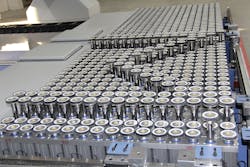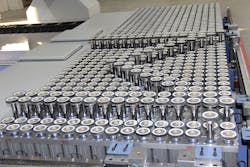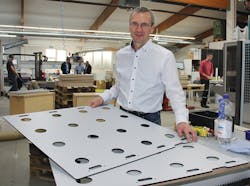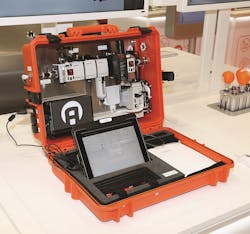Electrically Actuated Pneumatic Cylinders Cut Worktable Setup Times
Producing complex parts from wood, composite, and aluminum blanks is a challenge, especially in small batches. During machining or cutting, the material is supported on a pin table that must accommodate many different positions with various geometries on the same machine.
Schröder GmbH, based in Beckum, Germany, has cut its set-up times significantly for these operations with a new and unique pin table. Electronically controlled pneumatic cylinders extend within seconds, forming an inversion to the contours to be manufactured. Integrated vacuum suction cups then hold the material so machining can begin immediately.
“We have been experiencing a shift towards smaller batch sizes for years now,” states Jörg Schröder, CEO of Schröder GmbH. “Quantities in the thousands used to be the norm. Today, we often produce just between 50 and 100 units.” Although the NC-controlled processing units on the machinery are effective, set-up times can cause a bottleneck—especially when it comes to the work table. Saws, drills, and cutters require extra space below the workpiece to prevent damage to the table.
The pin table uses 48 Aventics pneumatic cylinder/valve units and integrated vacuum cups to support and hold complex workpieces for cutting and machining.
In the industry, it still is common to produce a base with the corresponding recesses and seals that can support the workpieces effectively. “With large batches, this is definitely efficient,” says Schröder. With smaller batches, it takes more effort to produce a single part and templates, register and manage them, then store them properly so they can be used again.”
Schröder GmbH produces series and variant products from wood, composites, and plastic. “As a supplier, we are constantly forced to optimize costs, and unproductive table set-up times are our greatest challenge,” explains the company’s CEO. As a master carpenter and electromechanical engineer, he conceived the idea of using an automatic pin table to flexibly release the cutting contours under the plates at a software command while holding the plates during machining for precise, secure processing.
Working with cylinder/valve unit supplier Aventics, he developed an innovative pin table for a new four-spindle portal machine from MKM International, Bad Oeynhausen, Germany. Now, with just a mouse-click, the cylinder/valve units move into position within seconds, holding the plate to be machined with integrated vacuum suction cups. The CNC program is loaded at the same time, so machining can begin without delay.
Vacuum suction cups hold workpieces in place.
From LEDs to Fully Automatic Pneumatics
The new design began with an idea Schröder implemented with MKM some years ago, when he converted a table using conventional manual pins to use plug-in pins with an LED at each position. A software program he developed transfers the part’s vacuum configuration defined in the CAD system during CNC programming to a separate mini-control, which then actuates the corresponding LEDs.
This provides the machine operator with a clear indication of exactly where pins must be plugged in. “Even so, setting up the machine table can take longer than the production of a small batch,” recalls Schröder. “I simply couldn’t accept that this process was not automated.”
To achieve this goal, he decided to replace the rigid metal pins on the pin table with compact pneumatic cylinder/valve units. The cylinder/valve unit is actuated electrically by a bus system he developed, and it can automatically implement the base templates created during programming. Programming itself is mostly automated. The vacuum program is assigned to the CNC program and both are transmitted to the machine together. The integrated vacuum system then secures the workpieces.
Bringing the Design to Reality
To make the concept a reality, Schröder designed a modular system consisting of four mobile tables, each measuring 1,200 by 800 mm and equipped with 48 cylinder-valve units with 2-in. bore, 4-in. stroke cylinders. Two tables can be synchronized together for a larger bracing surface.
Development of the pneumatics package with Aventics proceeded quickly. “Within a month, we developed this extraordinary cylinder/valve unit to run function and endurance tests,” recalls Alexander Minderlen, the employee responsible for the project at Aventics.
Eight directional valves and a control board from Schröder are integrated into the assembly base plate to protect them from dust and chips.
“We had to meet extremely specific requirements, such as height, width, integrated electronic components, and a vacuum system so that the solution could be retrofitted to already installed work tables,” explains Minderlen. The company delivered the eight-valve units preassembled and pneumatically tested. At Schröder, the processor board was then installed, and the finished assembly was enclosed with an aluminum cover.
The automated pin table provides production versatility with almost instant setup time.
Intelligent and Energy Efficient
Every one of the 384 cylinder/valve units on each table is equipped with an input and output, connected to the control software via a fieldbus. A four-wire cable is all that’s needed to control and monitor an entire table. With the optimally-sealed vacuum suction cups, the new pin table achieves better results than the previous design with much lower energy consumption.
It is crucial for the workpieces to be level. Per table, the cylinder end positions are consistent within 0.01 mm. “This is important so that we can precisely mill even the smallest of profiles on the edges of the plates,” explains Schröder.
His company now uses the first automated pin table with its new portal machine from MKM International. Its four tables traveling in the Y direction can be reached by four independent milling spindles, regardless of their location. In addition, two milling spindles are assigned to a drilling unit, and the remaining two spindles to a swiveling saw unit. With this equipment, tool change times are down to a minimum.
“We have reduced our set-up times significantly, and our production has become ultra-flexible and lightning-quick,” Schröder reports. He not only uses the automated table himself but also markets the solution for new and installed machines and systems in the wood and plastic processing sector and other industries.
Aventics Smart Pneumatics Analyzer, housed in a compact case, provides instant analysis options for key pneumatic characteristics of machines.
Smart Pneumatics Analyzer Offers Easy IIoT Entry
“Everyone is talking about the Industrial Internet of Things (IIoT), and a lot of companies are looking to take advantage of it,” says Andreas Kliewe, manager application & specification at Aventics. At this year's Hannover Fair, the company introduced its new Smart Pneumatics Analyzer (SPA). Users can connect the SPA to the compressed air supply of an existing machine to provide instant analysis options for key machine characteristic,s such as compressed air consumption and possible leaks.
“By digitalizing the pneumatic environment, the SPA provides users with the option to directly experience the benefits and potential of IIoT applications on their own machine in just a few simple steps,” says Dr. Michael Britzger, senior manager, digital transformation at Aventics. The unit’s portable case contains a Smart Pneumatics Monitor (SPM), an AS series maintenance unit, and a tablet for visualizing the live data.
The SPM initially detects the system operating state, analyzes data, and provides this processed information to users for functions such as status-oriented maintenance. All data from the valves, as well as from components connected to the I/O modules on the valve system, is read into a microprocessor and processed by means of mathematical algorithms. The company developed these algorithms through its expertise in product engineering and application.
“Based on the analysis results,” Britzger concludes, “we further develop the SPA together with our customers, especially for their applications.”
John Bridges is head of marketing at Aventics Corp., Lexington, Ky. For more information on products and services.





